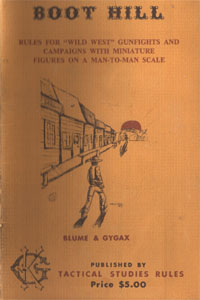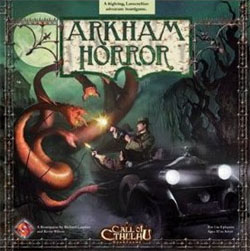As we wrap up our discussion of the hexcrawl game structure, I thought it might be interesting to take a few moments to revisit a few archaic game structures that have been abandoned by the hobby.
 Until recently, of course, the hexcrawl itself could be described as an archaic structure. By 1989 there were a few vestigial hex maps cropping up in products, but none of them were actually designed for hexcrawl play. The 2nd Edition of AD&D removed hexcrawling procedures from the rulebooks entirely. It wasn’t until Necromancer Games brought the Wilderlands back into print and Ben Robbins’ West Marches campaign went viral that people started to rediscover the lost art of the hexcrawl.
Until recently, of course, the hexcrawl itself could be described as an archaic structure. By 1989 there were a few vestigial hex maps cropping up in products, but none of them were actually designed for hexcrawl play. The 2nd Edition of AD&D removed hexcrawling procedures from the rulebooks entirely. It wasn’t until Necromancer Games brought the Wilderlands back into print and Ben Robbins’ West Marches campaign went viral that people started to rediscover the lost art of the hexcrawl.
The original game structure for hexcrawls described in OD&D is actually quite distinct from the hexcrawl procedures I described earlier (which were largely innovated by Judges Guild and than adapted into AD&D). The bulk of wilderness adventures in OD&D focused on castles:
Castles: As stated, the ponds [on the Outdoor Survival gameboard] indicate Castles. The inhabitants of these strongholds are determined at random. Occupants of these castles will venture out if a party of adventurers passes nearby. If passing over the castle hex there is a 50% chance (die 1-3) that they will come out, if one hex away there is a 33-1/3% chance (die 1-2), and if two hexes away there is only a 16-2/3% chance (die 1). If the party is on the castle hex and hails the castle, the occupants will come forth if the party is not obviously very strong and warlike. Patriarchs are always Lawful, and Evil High Priests are always Chaotic. All other castle inhabitants will be either hostile to the adventurers (die 1-3) or neutral (4-6).
This is followed by a random table for determining the occupant of a castle and their guards/retainers. Then specific procedures for each type of inhabitant are provided: Fighters will “demand a jousting match with all passersby of like class”, Magic-Users will “send passerby after treasure by Geas if they are not hostile, with the Magic-User taking at least half of all treasure so gained”, Clerics will “require passersby to give a tithe (10%) of all their money and jewels” and so forth.
A vestigial remnant of this structure survived all the way into the Rule Cyclopedia (where tables were still being presented to randomly determine the attitude of castle occupants), but I’m guessing it’s been essentially nonexistent in actual play since 1980 at the latest. And, unlike JG-style hexcrawling, I doubt these “castle occupant rides forth” game structures are likely to enjoy a significant renaissance any time soon.
(Although, on the other hand, there are some potentially interesting things lurking in there: First, the implied setting – in which civilization is so sparsely populated that feudal lords will ride out to meet travelers who pass anywhere within a dozen leagues of their walls – is a fascinating one. Second, note how the structure provides default scenario hooks: Like the treasure maps seeded randomly into OD&D hordes, the quests proffered by feudal lords can spontaneously transform the aimless exploration of the hexcrawl into specific direction. But I digress.)
The other major procedure for wilderness play in OD&D was the idea of “clearing” a hex of monsters (which was a prerequisite for establishing a barony or stronghold):
The player/character moves a force to the hex, the referee rolls a die to determine if there is a monster encountered, and if there is one the player/character’s force must remove it. If no monster is encountered the hex is already cleared. Territory up to 20 miles distant from a stronghold may be kept clear of monsters once cleared – the inhabitation of the stronghold being considered as sufficient to maintain the monster-free status.
This basic structure was greatly expanded in AD&D. (For example, it added a precise system for determining when and how monsters return to an area, along with all kinds of modifiers – like placing skulls and carcasses as warning signs.) And then it, too, faded away.
 In fact, if you look back at the early history of gaming you’ll find these kinds of explicit game structures all over the place: The system for artifact use in Gamma World, the mercantile models of Traveller, the posse and tracking system for Boot Hill (which, in the 2nd Edition, could be tied into a larger competitive structure of lawmen vs. outlaws), the status points of En Garde, and so forth.
In fact, if you look back at the early history of gaming you’ll find these kinds of explicit game structures all over the place: The system for artifact use in Gamma World, the mercantile models of Traveller, the posse and tracking system for Boot Hill (which, in the 2nd Edition, could be tied into a larger competitive structure of lawmen vs. outlaws), the status points of En Garde, and so forth.
What you had, in short, were a bunch of wargamers who were very familiar with creating specific game structures heavily laden with the details of world simulation: After all, they’d been using precisely defined game structures to model historical battlefields for years. Roleplaying games, however, cracked open the game world, and the game designers were applying game structures to a much wider “world simulation”.
Over time, for a variety of reasons, these explicit game structures became more and more simulationist in nature. As the focus shifted from structures that were fun to play to structures that were accurate “models of the game world”, however, the structures became rather boring and (as the details of the simulation became fetishized) often too complicated to use in actual play to any great effect.
What followed next (and this all happened over the course of only a few short years) was almost inevitable: The explicit game structures became vestigial and then, with the advent of universal systems, disappeared from rulebooks entirely. (With the notable exception, of course, of highly structured combat systems.)
But — and this is important to understand! — the game structures didn’t actually disappear from gaming! They are, after all, essential for play. Instead, a handful of the most popular structures became treated as a sort of common knowledge: Everybody “knew them”, so game designers didn’t bother explaining them. (Although, in truth, very few people really thought about them at all.)
In short, the general sense that playing an RPG consisted of nothing more than “the players tell me what they want to do and then we resolve it” settled over the industry. But, as we’ve seen, this is completely false. What happened in actual practice was that GMs would use a random grab-bag of unexamined techniques that they had collected from people they played with, published adventures, and the occasional unique insight. And this, of course, resulted in a lot of frustrating play.
The lack of explicit game structures in the rulebooks – particularly explicit scenario structures – also helped to make roleplaying games a lot less accessible to people who hadn’t played them before.
 Imagine that you took the rules for the boardgame Arkham Horror and you stripped out all the rules about explicit turn sequencing (i.e., the scenario structure of the game): Instead, you’re left with some rules about how to make skill checks; how far you can move around the board each turn; how to fight monsters; how you can move through gates and close them behind you; how you can fight Ancient Ones if they wake up; and so forth. But… what do you do with all those rules?
Imagine that you took the rules for the boardgame Arkham Horror and you stripped out all the rules about explicit turn sequencing (i.e., the scenario structure of the game): Instead, you’re left with some rules about how to make skill checks; how far you can move around the board each turn; how to fight monsters; how you can move through gates and close them behind you; how you can fight Ancient Ones if they wake up; and so forth. But… what do you do with all those rules?
And that, in short, is what virtually every RPG for the past thirty years except for D&D has looked like to newcomers. (And it is somewhat worrisome to note that every iteration of Dungeons & Dragons since 1983 has reduced the amount of explicit game structure in the core rulebooks until, finally, 4th Edition eliminated dungeoncrawling procedures almost entirely.)
But as we look back at the archaic era of explicit game structures, I think there is something else of import to note that may help to explain why they went way: With the exception of the ‘crawls and a few others, almost all of these game structures were fundamentally incomplete.












I certainly hope that you’re one of the consultants for dndnext. I always enjoy your analysis of the game.
This article has a great level of insight. You do a great job of breaking these ideas down to the basic concepts. Keep them coming.
Great article. You’re spot on with your analysis here. What you said about the 4e line struck me as well. My group has been playing a lot of 4e, and we figure it’s just not suited to real dungeons. The designers probably figure that most folks have moved away from dungeon crawling adventures. You know, “dungeon crawl” is a derogatory term in a lot of circles, rather than describing what the game is basically about (at least in its earliest iterations).
That Arkham Horror analogy is great.
Very good insights here. I’d be interested to see examples of what you would consider to be ‘common knowledge’ structures that GMs continue to use despite not appearing in the books. Here are a few from older game systems that I use in 4th edition D&D despite their not appearing there:
Wandering & Random Monster checks using a 1 in X frequency check and a random encounter table. From every edition of D&D prior to 4e.
Monster morale using 2d6 vs a number between 2 & 12, roll over morale number and monsters retreat or flee (from the BX-BECMI-RC D&D line).
War Machine % mass battle rules (from BECMI & RC D&D).
Hexes.
Campaign setting & society creation from various, but especially from 1e AD&D.
I want to have dominion rulership from AD&D and BECMI/RC Dominion rules, with harvested taxes, monthly events etc, but have not managed to do so yet. Few players know what I’m talking about. Some are very wary of this being a ‘different game’ from dungeon-delves.
These range from the specific (War Machine % mass warfare) to things like hexes and random encounters that do possibly constitute a virtual lingua franca among older D&D players. They are things much hated by ‘rpgnetter’ types, though, whose references are Vampire, Exalted, and ’90s style ‘railroad & metaplot’ gaming.
This helps me understand why I felt the need to include a simple “village, dungeon, town” structure as part of my own modular heartbreaker. I wanted to put as many of the assumptions in as I could for starting players.
Very interesting series of articles. Even though at this point I don’t have much to add to the discussion I just wanted to let you know I’m enjoying reading them very much.
@S’mon: A lot of what I’m thinking of in terms of vestigial structures can actually be hard to quantify (specifically because people aren’t consciously thinking about them).
As an example that may be a bit easier to communicate, consider the example of a GM who only has experience with White Wolf’s World of Darkness. This was somewhat more common, at least in my experience, back in the ’90s. And on at least two occasions I found myself playing at a table where the GM was faced with a scenario that would have been best served with a typical D&D-style location crawl. One had no idea what to do; the other had only the vaguest sense of it all: They struggled with basic tasks like figuring out who was in which room and the like.
For a more contemporary example, I’ve seen (or talked to) several GMs who were introduced to D&D with 3E or 4E and who struggle with exactly how to adjudicate a Search check.
This is a bit of a cheat because I’m certainly not advocating a strict return to, say, the OD&D guideline of “searching a 10′ wall for secret doors takes 1 round”. But OD&D could get away with a specific guideline like that because the mechanic was very specific in its application. A lot of older GMs started with a specific guideline like that and then, as the scope of “searching” began to expand from one iteration of the game to the next, intuitively learned how to expand the adjudication of a Search check to match.
Some newer players who didn’t experience that rock hard foundation and the slow expansion that followed end up completely adrift: I’ve seen them use everything from “riding Search checks” (with a Search check result sticking around until it finds something) to “make a separate check for every 5′ square” (which resulted in some of the most mind-numbingly boring gameplay I have ever experienced).
Thanks Justin. I agree that vestigial structures often become most obvious in their absence, when encountering a GM not aware of them. Most notably, GMs who are only aware of ’90s ‘railroad’ adventure design but are GMing adventures where hexcrawl or similar open-sandbox design would make more sense. Some of the GM advice in the 4e DMG seems to indicate that the writers may actually have been unaware of some useful archaic structures.
[…] С оригиналом статьи Вы можете ознакомиться здесь. […]
Have you played Torchbearer or Mouse Guard RPG by BWHQ? They have very explicit game structures–so much so that the games break if you ignore the rules and leave the highest-level structure–and it’s interesting how many modern RPG players seem to completely bounce off them thanks to the instinct to mess with the games they’re playing before really understanding them. I think it speaks to just how ingrained the idea of ignoring the rules you’re using–and not really thinking about game structures–is in the modern hobby.